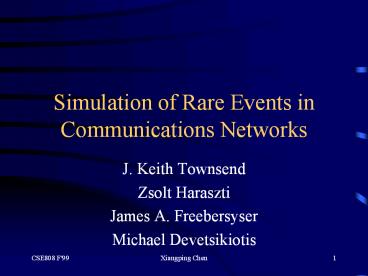Simulation of Rare Events in Communications Networks PowerPoint PPT Presentation
Title: Simulation of Rare Events in Communications Networks
1
Simulation of Rare Events in Communications
Networks
- J. Keith Townsend
- Zsolt Haraszti
- James A. Freebersyser
- Michael Devetsikiotis
2
Background
- Rare event probabilities in communication
networks. - Require prohibitively long simulation times
- How to reducing simulation execution time while
retain the ease and flexibility of simulation?
--- Importance Sampling based techniques.
3
What is IS?
- Combination of analysis and simulation.
- Modifying (biasing) the underlying probability
mass so that the rare events occur much more
frequently. - Results are weighted to yield a statistically
unbiased estimator.
4
Objective
- Significant reduction in the number of trials
while maintain the estimator precision. - Which parameter(s) of the system to bias?
- How much to bias each of them?
- What is the speedup?
5
Importance Sampling example
6
Techniques
- Modification of Individual Stochastic Elements
- Global Modification via Trajectory Splitting
7
Modification of Individual Stochastic Elements
- Modifying the probability distributions of one or
more random number generators in the simulation
model. - Requires considerable prior knowledge about the
system.
8
Global Modification via Trajectory Splitting
- Assumption some well identifiable intermediate
system states are visited much more often than
the target states and behave as gateway states to
reach the target states. - Entering the intermediate states triggers the
splitting of the trajectory. - Step-by-step evolution of the system follows the
original probability measure.
9
Trajectory splitting Example - DPR
- DPR - Direct probability redistribution
- Partitions the state-space S into m subsets, S1,
S2, Sm. - Oversampling factors, ?1 lt ?2 lt ... lt ?m.
- Every state Si is visited ?i more times.
- Unbiased factors are obtained by weighting a
subset-dependent factor 1/? ?(Si).
10
Tuning/Optimization of Parameters
- Large deviations, effective and decoupling
bandwidths - Stochastic optimization
- Conditional biasing
- Iterative balancing for trajectory splitting
11
LDT - Large Deviation Theory
- Specify the biased distributions as ? -conjugate
exponentially twisted versions of original,
unbiased distribution. - Effective bandwidths is invoked to determine the
value of ?. - A(?) lim n?? (1/n)log E exp? ?ni1 Ai
- d(?) A(?) / ? is the effective Bandwidth.
12
LDT Continued
- ? value is equal to the service rate in a
single queue with deterministic service. - Additive property of effective bandwidths is used
to describe multiple streams sharing the same
queue. - Decoupling bandwidths is used to provide
sufficient conditions of a specific tagged stream.
13
Stochastic Optimization
- The mean field annealing (MFA) algorithm is a
variant of simulated annealing (SA) that avoids
local minima and arrives at optimal solutions in
more rapid convergence. - The stochastic gradient descent (SGD) algorithm
can potentially zero in on favorable bias
parameter settings fast by exploiting more
information at hand.
14
Conditional Biasing
- An important IS technique that is effective in
uniform probability distributions (UPD). - Prior knowledge is used to partition the UPD into
intervals that result in the important events or
not. - Requirement occurrence of any sequence of
random variables resulting in an important events
not be excluded from the biased random variable
selection process.
15
Iterative Balancing for Trajectory Splitting
- To find appropriate partitioning
- To choose the correct amount of splitting
- Near optimal ? setting is when the subset
probability masses are equalized. - A simple iterative procedure can explore subset
probabilities in a step-by-step fashion.
16
Application Examples
- Steady-state simulation of cell loss probability
- Regenerative method or A-cycles
- Application of stochastic optimization
- Tandem ATM network
- Application of Conditional Biasing
- ATM switch is described using operational
approach - Application of DPR-based Splitting Simulation
- Systems with internal loop
17
Conclusion
- Proves to be effective although it requires
problem-specific analytical phase - Simulation will be used to evaluate more
complicated networks - More reliable networks will be characterized by
rarer events - IS is more important in the future.

